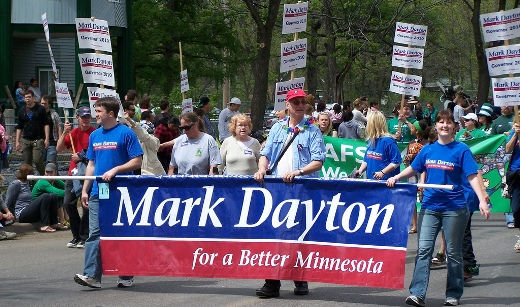
ST. PAUL, Minn. (PAI) – Mark Dayton may become very important in 2011.
Assuming he wins the open Minnesota governor’s seat – and he has a double-digit lead in a 3-way race – the former Democratic U.S. senator, who has united labor backing, will be in a powerful position in the governor’s chair in St. Paul.
And so will three dozen of his colleagues elected on Nov. 2.
The nation’s governors play a key role in implementing federal policy – and none more so than in the next three years – when the states will have to do the heavy lifting on setting up competition in the health care sector, as part of the health care reform law Democratic President Barack Obama pushed through Congress.
But the governors also have another key role next year: Helping determine who gets to represent you in your state capital and in Washington, D.C.
That’s because, after the 2010 Census data are released, congressional seats and state legislative seats will shift all over the country. And with only a few exceptions, governors will have a big say in those remapping plans.
With 23 governors either retiring or in political trouble this year – including in all the big states of Illinois, New York, California, Ohio, Pennsylvania, Michigan, Florida and Texas, as well as Minnesota and Oregon and elsewhere – who wins those races becomes especially significant.
That’s where Dayton comes in, and he may be one of the few Democratic bright spots on election night, Nov. 2. Minnesota has a Democratic legislature, too. That would give the party an opportunity to redraw district lines and maximize workers’ representation in St. Paul and D.C.
Such possibilities for creative cartography next year are the reason the governors’ races are so important, even if they’re often overlooked. Redistricting shenanigans by Republicans in Texas, Ohio, Florida, Michigan and Pennsylvania left workers and their allies at a disadvantage after the 2000 census. The same thing happened – in reverse – in California.
And that governor’s race, between Republican former E-Bay CEO Meg Whitman – who has dumped $119 million of her own money into it – and Democratic Attorney General Jerry Brown, who at age 72 wants his old job back, is the big enchilada. That’s because the Golden State has 53 congressional seats (34D, 19R).
Not far behind is Illinois, which may well lose a seat after the counting gets done. That makes the redistricting battle especially key for workers. And that’s why it’s important that pro-worker Democratic Gov. Pat Quinn has recently surged to a tie in the polls with his foe, an anti-worker GOP construction contractor who wants to turn Illinois into a “right-to-work” state.
“Bill Brady is the largest ABC-affiliated non-union construction contractor in the state,” says Marty Helfers of the West Central Illinois Building and Construction Trades Council. “And his running mate is number two. They’re against Project Labor Agreements and the running mate wants to repeal the minimum wage.”
The Texas race is important for the same reason. The Lone Star State may gain up to four U.S. House seats to go along with its present 32. But former Houston Mayor Bill White (D) is closing the gap in the polls against 10-year GOP Gov. Rick Perry, who has alienated voters – since he took over for George W. Bush – by talking of “secession” and refusing federal education dollars. White also has sufficient campaign cash to compete in Texas’ many media markets.
Labor, though few in numbers, has an extra incentive in the Texas race: Texas’ lieutenant governor is one of the most powerful such officials in the United States, and White’s running mate is former AFL-CIO Executive Vice President Linda Chavez-Thompson.
Other big states with governors’ races include Pennsylvania, Florida, New York, Michigan, Massachusetts and Ohio. In all but Florida, the incumbent Democratic governor is either retiring or under siege. In Ohio, incumbent Democrat Ted Strickland has cut his deficit in the polls from 10 percentage points to four. He faces GOP congressman-turned-Wall Street bond trader John Kasich.
And keeping Strickland in the job – the top goal of the state fed – may be all that stands between workers and another gerrymander by the GOP-run state legislature.
In only one of the big states, New York, does the Democrat, state Attorney General Andrew Cuomo, appear to have a lead. His opponent, tea party-pushed GOP businessman Carl Paladino was behind in the polls even before his threat to slug a New York Post reporter who was asking him about his unsubstantiated charges of Cuomo’s marital infidelity went viral on the Internet. Paladino has a 10-year-old daughter out of wedlock, besides children he sired with his wife.
Neither, of course, is talking much about New York’s massive deficit, and how to close it. Retiring Democratic Gov. David Patterson has fought state unions over his plans to slash jobs.
But the key to all the races – for governor as well as other offices – is turnout. If labor rolls up its sleeves and gets its members and their families and friends to the polls, they have a shot at winning state capitals as well as other offices.
In Illinois, Helfers is shooting for having one-third of the state electorate this fall be workers and their allies. That would be a record. If they are, Quinn wins, and workers’ political allies nationwide would defy the pundits’ predictions and win elsewhere, too.
Photo: From the Twin Cities, Minnesota 2010 May Day parade. Mpls55408/CC










